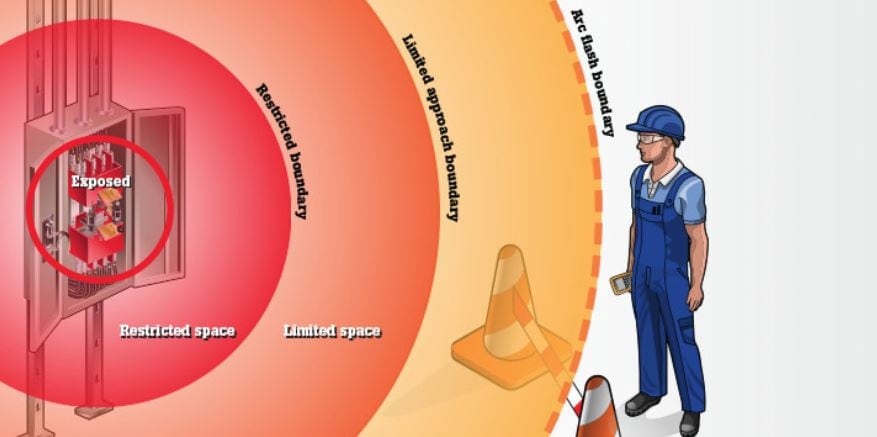 When it comes to respecting arc flash boundaries, industrial professionals should be aware of the right safety measures to take. A flash might last only microseconds, but it could prove deadly – carrying thousands of amps of energy.
When it comes to respecting arc flash boundaries, industrial professionals should be aware of the right safety measures to take. A flash might last only microseconds, but it could prove deadly – carrying thousands of amps of energy.
An arc flash can be caused by multiple scenarios
- A metallic object makes contact with energized conductors or circuit parts.
- A spike from inductive load switching or a lightning strike.
- A person accidentally touches a test probe to the wrong surface.
- Worn connections.
- Gaps in insulation.
- Improperly installed parts.
- Dust and corrosion that cause resistance heating.
Here are safety measures workers can take to reduce the risk of arc flash:
Arc flash boundaries: Get trained on safe work practices
All employees who may potentially be exposed to electrical hazards must undergo arc flash training. (OSHA regulation 29CFR1910.332 and NFPA 70E.) Trainings help workers:
- Identify and avoid electrical hazards.
- Maintain proper personal protective equipment (PPE) standards.
- Understand how electrical equipment and power systems operate.
- Become skilled in testing for the presence and absence of voltage.
De-energize equipment before accessing
- Until electrical circuits are tested and found absent of voltage, they must be considered energized.
- Inspect test instruments and verify them with a known voltage source.
- De-energize equipment through established lockout-tagout practices.
- Reverify the meter is functioning properly.
Conduct regular inspections
Knowing the maintenance history of the equipment in your facility is one of the first steps to preventing an arc flash event. The key to identifying an abnormal reading is to gather baseline readings for especially important components and equipment.
Critical components to inspect include electrical connections, insulation and circuit breakers.
Follow the hierarchy of risk control
Again, wearing the appropriate PPE is critical to minimizing injury in the event of an arc flash incident. For PPE to perform effectively, its arc thermal performance value must meet – or exceed – the thermal energy transfer during a potential arc flash incident.
Select tools rated for the environment
- Test instruments, test probes, flexible clamps and other accessories must meet safety requirements established by such organizations as the American National Standards Institute (ANSI), Canadian Standards Association (CSA) and International Electrotechnical Commission (IEC).
- Make sure your meter and accessories have the appropriate CAT and voltage rating for the electrical environment in which you will use them.
Use remote display or wireless test tools
Extend your safety zone with noncontact or wireless test tools. These allow you to take readings on an energized part without making contact. Some of the most common noncontact tools for electrical inspections include:
- Noncontact voltage detectors
- Infrared thermometers
- Visual infrared thermometers
- Infrared cameras
Install infrared windows for switchgear inspection
Installing properly certified infrared windows allows technicians to inspect electrical equipment without removing the panel cover. That makes it easier for companies to comply with NFPA 70E when inspecting switchgear and motors.
This blog post was drafted in partnership with Fluke. Check out Fluke’s original article, “Top 7 arc flash safety measures.”
Related posts
Common electrical safety mistakes to avoid during testing
Measure voltage without test leads with Fluke’s T6 Electrical Tester